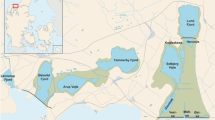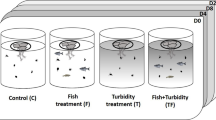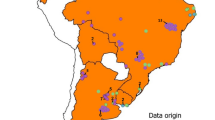Abstract
To explain summer declines in phytoplankton biomass in large rivers, we compared the effect of zooplankton grazing on the planktonic algae of two large European rivers, the Meuse and the Moselle. In situ grazing was measured during two years (1994 and 1995), using the Haney method. Total zooplankton community filtration rates recorded in the river Meuse ranged between 1 and 32% of the water volume filtered per day. A drastic algal decline was observed early July both years and may be explained by high densities of a rotifer-dominated zooplankton community (500–700 ind. l-1) with more than 75% of Brachionus calyciflorus. During the summer period in 1994, when grazing was over 20%, edible algal biomass was controlled by a diversified rotifer community (up to 2500 ind. l-1), while a non-edible algal assemblage developed. In contrast, phytoplankton biomass remained comparatively low in the Moselle throughout the low-flow period, as did zooplankton numbers during most of this time (fewer than 200 ind. l-1 during the summer period). The proportion of crustaceans in this zooplankton was rather higher than in the Meuse, and they dominated at times, in biomass as well as in numbers. Nevertheless, measured in situ grazing rates (1–15%) could not explain the low summer algal biomass, even if low filtration rates may at times represent a significant carbon loss for phytoplankton, when and where net algal production was low. As a conclusion, the role of phytoplankton – zooplankton interactions in controlling algal biomass in large rivers is discussed.
Similar content being viewed by others
References
Admiraal, W., L. Breebart, G. M. J. Tubbing, B. van Zanten, E. D. de Ruyter van Steveninck & R. Bijkerk, 1994. Seasonal variation in composition and production of planktonic communities in the lower River Rhine. Freshwat. Biol. 32: 519–531.
Aldridge, C. W., B. S. Payne & A. C. Miller, 1995. Oxygen consumption, nitrogenous excretion, and filtration rates of Dreissena polymorpha at acclimation temperatures between 20 and 32 °C. Can. J. Fish. aquat. Sci. 52: 1761–1767.
Bachmann, V., E. Cegielka, P. Wagner, P. Usseglio-Poltera & J. C. Moreteau, 1997. Installation de l'amphipode Corophium curvispinum et de la palourde asiatique Corbicula sp. dans le cours franc¸ais de la Moselle – Establishment of the Amphipod Corophium curvispinum and the Asiatic Clam Corbicula sp. in the French part of the Mosel river. Hydroécol. Appl. 7: 185–191.
Basu, B. K. & F. R. Pick, 1997. Phytoplankton and zooplankton development in a lowland, temperate river. J. Plankton Res. 19: 237–253.
Böhme, M., 1994. Release and consumption of oxygen by a phytoplankton dominated community of a eutrophic lowland river. Verh. int. Ver. Limnol. 25: 1585–1589.
de Ruyter van Steveninck, E. D., W. Admiraal, L. Breebaart, G. M. J. Tubbing & B. van Zanten, 1992. Plankton in the River Rhine: structural and functional changes observed during downstream transport. J. Plankton Res. 14: 1351–1368.
Descy, J.–P., 1993. Ecology of the phytoplankton of the River Moselle: effects of disturbances on community structure and diversity. Hydrobiologia 249: 111–116.
Descy, J.–P. & C. Willems, 1991. Contribution á la connaissance du phytoplancton de la Moselle (France). Cryptogamie, Algol. 12: 87–100.
Descy, J.–P. & V. Gosselain, 1994. Ecological importance and dynamics of phytoplankton in a large lowland river (River Meuse, Belgium). Hydrobiologia 289: 139–155.
Descy, J.–P. & A. Métens, 1996. Biomasspigment relationships in potamoplankton. J. Plankton Res. 18: 1557–1566.
Descy, J.–P., P. Servais, J. S. Smith, G. Billen & E. Everbecq, 1987. Phytoplankton biomass and production in the River Meuse (Belgium). Wat. Res. 21: 1557–1566.
Downing, J. A. & F. H. Rigler, 1984. A manual on methods for the assessment of secondary productivity in fresh waters. IBP Handbook 17; Blackwell scientific publications, Oxford.
Effler, S. W., C. M. Brooks, K. Whitehead, B. Wagner, S. M. Derr, M. Perkins, C. A. Siegfried, L. Walrath & R. P. Canale, 1996. Impact of zebra mussel invasion on river waterquality. Wat. Env. Res. 68: 205–214.
Garnier, J., G. Billen & M. Coste, 1995. Seasonal succession of diatoms and chlorophyceae in the drainage network of the River Seine: Observations and modelling. Limnol. Oceanogr. 40: 750– 765.
Gawler, M. & R. Chapuis, 1987. An improved version of the Haney grazing chamber. Freshwat. Biol. 18: 1–4.
Gosselain, V., J.–P. Descy & E. Everbecq, 1994. The phytoplankton community of the River Meuse, Belgium: seasonal dynamics (year 1992) and the possible incidence of zooplankton grazing. Hydrobiologia 289: 179–191.
Gosselain, V., L. Viroux, & J.–P. Descy, 1998. Can a community of small-bodied grazers control phytoplankton in rivers? Freshwat. Biol. 39: 9–24.
Gosselain, V., C. JoaquimJusto, L. Viroux, M. Mena, A. Métens, J.–P. Descy & J.–P. Thomé, 1996. Laboratory and in situ grazing rates of freshwater rotifers and their contribution to community grazing rates. Arch. Hydrobiol. Suppl. 113: 353–361.
Hamilton, P., 1990. The revised edition of a computerized plankton counter for plankton, periphyton and sediment diatom analyses. Hydrobiologia 194: 23–30.
Haney, J. F., 1971. An in situ method for the measurement of zooplankton grazing rates. Limnol. Oceanogr. 16: 971–977.
Köhler, J., 1995. Growth, production and losses of phytoplankton in the lowland River Spree: carbon balance. Freshwat. Biol. 34: 501–512.
MacIssac, H. J., C. J. Lonnee & J. H. Leach, 1995. Suppression of microzooplankton by zebra mussels: importance of mussel size. Freshwat. Biol. 34: 379–387.
MacIsaac, H. J., W. G. Sprules, O. E. Johannsson & J. H. Leach, 1992. Filtering impacts of larval and sessile zebra mussels (Dreissena polymorpha) in western Lake Erie. Oecologia 92: 30–39.
Marneffe, Y., J.–P. Descy & J.–P. Thomé, 1996. The zooplankton of the lower River Meuse, Belgium: seasonal changes and impact of industrial and municipal discharges. Hydrobiologia 317: 1–16.
Reynolds, C. S., 1986. Experimental manipulations of the phytoplankton periodicity in large limnetic enclosures in Blelham Tarn, English Lake District. Hydrobiologia 138: 43–64.
Reynolds, C. S. & J.–P. Descy, 1996. The production, biomass and structure of phytoplankton in large rivers. Arch.Hydrobiol. Suppl. 113: 161–187.
RIWA, 1996a. Rapport annuel 1994 – Tome B: la Meuse, RIWA, Amsterdam, septembre 1996, 144 pp.
RIWA, 1996b. Rapport annuel 1995 – Tome B: la Meuse, RIWA, Amsterdam, février 1996, 128 pp.
Smayda, T. J., 1978. From phytoplankters to biomass. In Sournia, A. (ed), Phytoplankton Manual. UNESCO, Paris: 273–279.
Sprung, M., 1995. Physiological energetics of the zebra mussel Dreissena polymorpha in lakes. II. Food uptake and gross growth efficiency. Hydrobiologia 304: 133–146.
Vannote, R. L., G. W. Minshall, K. W. Cummins, J. R. Sedell & C. E. Cushing, 1980. The river continuum concept. Can. J. Fish. aquat. Sci. 37: 130–137.
Viroux, L., 1997. Zooplankton development in two large lowland rivers, the Moselle (France) and the Meuse (Belgium), in 1993. J. Plankton Res. 19: 1743–1762.
Rights and permissions
About this article
Cite this article
Gosselain, V., Descy, JP., Viroux, L. et al. Grazing by large river zooplankton: a key to summer potamoplankton decline? The case of the Meuse and Moselle rivers in 1994 and 1995. Hydrobiologia 369, 199–216 (1998). https://doi.org/10.1023/A:1017071909997
Issue Date:
DOI: https://doi.org/10.1023/A:1017071909997




